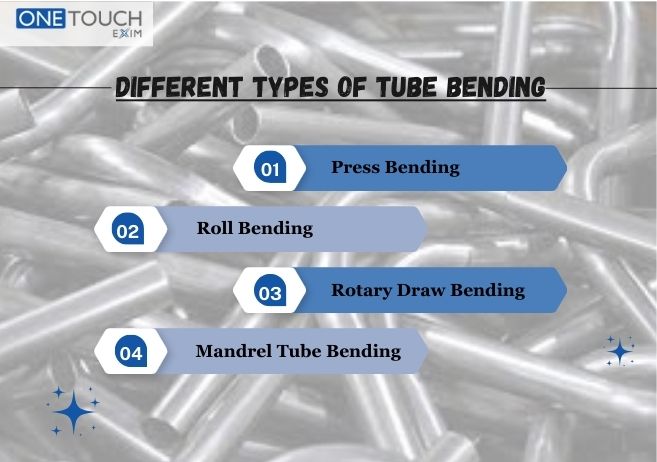Tube Bending or pipe bending is the metalworking process of bending tubes and pipes that transform straight tubes into curved shapes, squares, and rectangles for different metal fabrication purposes. Aluminium, stainless steel, mild steel, titanium, and brass are some materials used for tube manufacturing. The most common types of bend shapes are L bends, U bends, S bends and coil bends. Tubes have higher structural integrity as compared to other metal shapes as we all know straight tubes cannot be used for stair railings, handles, furniture frames, etc. That’s Why tube bending is used so that the tube can be reshaped as a whole without cutting and welding the tube itself. Processes like cutting and welding of the tube can weaken the structure’s integrity compared to the bent tube structure. Let us discuss the tube bending methods used for bending tubes
Methods of Tube bending
There are some highlighted methods of tube bending which are as follows:
1) Hot Tube Bending
As the name suggests, hot tube bending is the process in which we heat the tube at a very high temperature so that the bending process becomes easier. Metals like aluminum, stain steel, brass, etc become flexible and easier at high temperatures so they can bend easily with lesser force and don’t break.
2) Cold Tube Bending
The cold tube bend method doesn’t require the heating of metal at higher temperatures. This tube bending can be done at room temperature. The biggest advantage of this method is that it provides higher accuracy because of no change in the final dimensions of the metal due to the temperature change.
Different types of Tube Bending
The different types of tube bending are as follows:
1) Press Bending
It is one of the simplest and oldest techniques of pipe bending. In this bending technique, two dies are inclined at the required angle and are placed against the pipe that is going to bend. When these pressure die are applied to the tube the shape of the bend is imprinted on the bend. The main advantage of using pressure bending is that the cost of bending is cheap and the speed of bending is fast.
2) Roll Bending
The roll bending method consists of two stationary and one moving roller in a pyramid pattern. The stationary roller rotates against the moving roller and the roller pushes the pipe from the coil at the required angle. Types of Roll Bending:
- Simple Three Roll Bending – It pushes and bends the tube.
- Three Roll Simple Bending – This technique is used when a tube is required with Multiple bending curves.
The major advantage of roll bending is that the tube can be bent in different sizes without changing tooling.
3) Rotary Draw Bending
Rotary draw bending is one of the best and most commonly used bending techniques. This technique uses a set of interlocking dies and the tube is internally supported by mandrel. Rotary draw bending techniques are found in pipe fitting, instrument tubing, handrails, and automotive and aerospace parts. This technique is also used for hollow sections with different shapes. The biggest advantages of using rotary draw bending are highly accurate bends, high precision, and bends at high speed. With advantages it also has some disadvantages, for different shapes of bend and tube, different tools are required which increases the overall cost of rotary draw bending setup.
4) Mandrel Tube Bending
Mandrel tube bending is a process that involves the first insertion of a mandrel or rod inside the hollow tube as it is being formed and starts supporting the tube internally to protect it from collapsing during the bending process. The internal support bar is of a slightly smaller diameter than the tube on which bending is performed. Mandrel tube bending is used in the manufacturing of exhaust pipes for automobiles, aerospace equipment, and exercise equipment. The benefit of using mandrel tube bending has better accuracy, protects the tube from damage, and has high repeatability.
The important factor to consider before choosing tube bending
When considering which type of tube bending technology to use, there are always certain factors to consider. The Factors are:
1) Budget
Budget is the main factor for limiting the choice of bending. There are always better technologies present but we have to check whether it is pocket-friendly or not.
2) Precision
The accuracy provided by different technologies can vary by day and night. Check the precisions needed in your bend.
3) Workable Size
Some methods work well on thin tubes and some methods work well on thick tubes, choose the method that will work well with your tube thickness.
4) Bend Angle
Methods like rotary draw bending work well with large bend angles while methods like ram bending work well with small bend angles. So, based on your requirements invest your money in the best bending machines.
Conclusion
Tube bending is the mechanical process that is used to change the structure of a tube permanently. Which tube can be used for different purposes such as furniture frames, stairways, etc. The tube bend is dependent on different tools, angles, geometry, and tubing material which allows for change in the shape of the tube without affecting the integrity of the new structure which could lead to we use of welding or cutting. In this, we have also discussed the methods of tube bending such as hot tube bending and cold tube, and their benefits. Later on, we discussed the types of tube bending processes that are generally used in industries to change the structure of the pipe and their benefits of using them. Afterward, we concluded with the important factors to check before choosing tube bending for any tube bend requirement.
